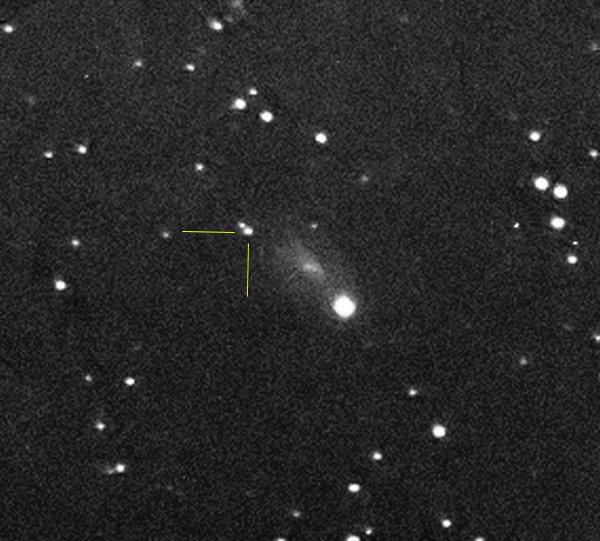SN 2011fd (A.R. 06 46 39.85, Dec. +60 21 02.8) scoperta il 20 agosto 2011 nella galassia NGC 2273B (offset 60E 36N), magnitudine 15.0, tipo II.
SN scoperta da Alessandro Dimai con il telescopio Schmidt Cassegrain da 11" dell'Osservatorio del Col Drusciè (Cortina d'Ampezzo) . La PSN è presente su due immagini di 60 secondi di posa, magnitudine limite circa 18.0.
NGC 2273B è una galassia SB nella costellazione della Lince, distante 28.7 Mpc, magnitudine 13.1.

Electronic Telegram No. 2791
Central Bureau for Astronomical Telegrams
INTERNATIONAL ASTRONOMICAL UNION
CBAT Director: Daniel W. E. Green; Hoffman Lab 209; Harvard University;
20 Oxford St.; Cambridge, MA 02138; U.S.A.
e-mail: Questo indirizzo e-mail è protetto dallo spam bot. Abilita Javascript per vederlo. (alternate Questo indirizzo e-mail è protetto dallo spam bot. Abilita Javascript per vederlo. )
URL http://www.cbat.eps.harvard.edu/index.html
Prepared using the Tamkin Foundation Computer Network
SUPERNOVA 2011fd NEAR NGC 2273B = PSN J06463985+6021028
Alessandro Dimai, Cortina d'Ampezzo, Italy, reports his discovery of an
apparent supernova (mag 15.0) on two CCD images (limiting mag about 18.0)
taken in the course of the Italian Supernovae Search project with a Celestron
C11 0.3-m telescope (+ SBIG ST8 camera) on Aug. 20.12 UT. The new object
(designated PSN J06463985+6021028 when posted on the Central Bureau's TOCP
webpage and designated SN 2011fd here based on the spectroscopic report below)
is located at R.A. = 6h46m39s.85, Decl. = +60d21'02".8 (equinox 2000.0), which
is 60" east and 36" north of the galaxy NGC 2273B. Nothing is visible at this
position on Dimai's image from 2011 Apr. 21 (no limiting magnitude provided)
or on Palomar Sky Survey red and blue plates (no dates or limiting magnitudes
provided). Additional unfiltered CCD magnitudes for 2011fd: Aug. 21.124,
14.8 (Dimai); 22.112, 15.1 (Dimai; image posted at the following website URL:
http://www.cortinastelle.it/cross/PSN_J06463985+6021028_20110822_024156UT.jpg);
23.42, 15.4 (R. A. Koff, Bennett, CO, USA; Meade 0.25-m f/10 Schmidt-Cassegrain
telescope + Apogee AP-47p camera; position end figures 39s.74, 02".0; image at
http://antelopehillsobservatory.org/SNpictures/PSNJ06463985+6021028final.jpg);
23.449, 15.6 (Joseph Brimacombe, Cairns, Australia; position end figures
39s.77, 02".8; image at http://www.flickr.com/photos/43846774@N02/6075087091/.
L. Magill, Queen's University, Belfast, and Isaac Newton Group; R. Kotak,
Queen's University, Belfast; A. Pastorello, Osservatorio Astronomico di
Padova, Instituto Nazionale di Astrofisica (INAF), Universita di Padova; and
P. Ochner, Osservatorio Astronomico di Padova, INAF -- on behalf of a larger
collaboration -- report that an optical spectrum (range 385-900 nm) of PSN
J06463985+6021028 = SN 2011fd was obtained at the Nordic Optical Telescope (+
ALFOSC spectrograph) by J. Lykke on Aug. 20.2 UT. The spectrum shows broad
P-Cyg Balmer lines superimposed on a relatively blue continuum, suggestive of
a young type-II-plateau supernova. The H_alpha profile is dominated by a
broad emission component, the absorption trough being barely perceptible.
The H_beta and H_gamma profiles, on the other hand, display classical P-Cyg-
type profiles; the average expansion velocity, as estimated from the blue
edge of the absorption troughs of these lines, is about 10000 km/s, after
correcting for the recession velocity of NGC 2273B (2101 km/s; from de
Vaucouleurs et al. 1991, Third Ref. Cat. of Bright Galaxies, Ver. 3.9; via
NED website). A broad feature, likely due to He I 587.6-nm, is also
apparent in the spectrum. Weak lines of Fe II (multiplet 42) are also
detected. Cross-correlation with a library of supernova spectra using the
"Supernova Identification" code (SNID; Blondin and Tonry 2007, Ap.J. 666,
1024) confirms a type-IIP identification, with SNe 2004et (Sahu et al.
2006, MNRAS 372, 1315) and 1999em (Baron et al. 2000, Ap.J. 545, 444),
providing good matches for epochs ranging from a few days pre-peak to about
one week post-peak.
NOTE: These 'Central Bureau Electronic Telegrams' are sometimes
superseded by text appearing later in the printed IAU Circulars.
(C) Copyright 2011 CBAT
2011 August 24 (CBET 2791) Daniel W. E. Green




